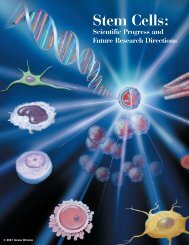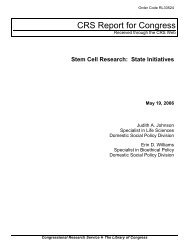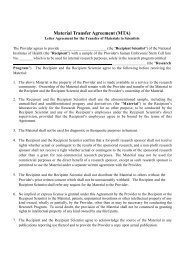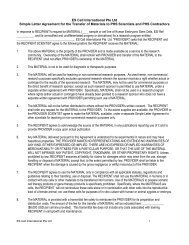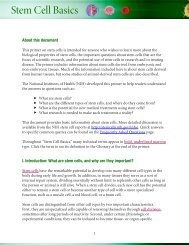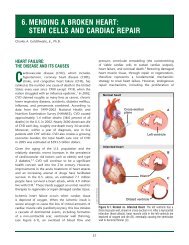8 Alternate Methods for preparing pluripotent Stem Cells
8. alternate methods for preparing pluripotent stem cells
8. alternate methods for preparing pluripotent stem cells
Create successful ePaper yourself
Turn your PDF publications into a flip-book with our unique Google optimized e-Paper software.
8. <strong>Alternate</strong> <strong>Methods</strong> <strong>for</strong> <strong>preparing</strong><strong>pluripotent</strong> <strong>Stem</strong> <strong>Cells</strong>James F. Battey, Jr., MD, PhD; Laura K. Cole, PhD; and Charles A. Goldthwaite, Jr., PhDThe Clinical Application ofPluripotent <strong>Cells</strong>: The Promiseand the Challenges<strong>Stem</strong> cells are distinguished from other cells by twocharacteristics: (1) they can divide to produce copies ofthemselves (self-renewal) under appropriate conditionsand (2) they are <strong>pluripotent</strong>, or able to differentiateinto any of the three germ layers: the endoderm(which <strong>for</strong>ms the lungs, gastrointestinal tract, andinterior lining of the stomach), mesoderm (which<strong>for</strong>ms the bones, muscles, blood, and urogenitaltract), and ectoderm (which <strong>for</strong>ms the epidermaltissues and nervous system). Pluripotent cells, whichcan differentiate into any mature cell type,are distinct from multipotent cells (such ashematopoietic, or blood-<strong>for</strong>ming, cells) thatcan differ into a limited number of mature celltypes. Because of their pluripotency and capacity<strong>for</strong> self-renewal, stem cells hold great potentialto renew tissues that have been damaged byconditions such as type 1 diabetes, Parkinson’sdisease, heart attacks, and spinal cord injury.Although techniques to transplant multipotentor <strong>pluripotent</strong> cells are being developed <strong>for</strong>many specific applications, some proceduresare sufficiently mature to be established options<strong>for</strong> care. For example, human hematopoieticcells from the umbilical cord and bone marroware currently being used to treat patients withdisorders that require replacement of cells madeby the bone marrow, including Fanconi’s anemiaand chemotherapy-induced bone marrow failureafter cancer treatment.However, differentiation is influenced bynumerous factors, and investigators are justbeginning to understand the fundamentalproperties of human <strong>pluripotent</strong> cells. Researchersare gradually learning how to direct these cellsto differentiate into specialized cell types and to usethem <strong>for</strong> research, drug discovery, and transplantationtherapy (see Figure 8.1). However, be<strong>for</strong>e stemcell derivatives are suitable <strong>for</strong> clinical application,scientists require a more complete understandingof the molecular mechanisms that drive <strong>pluripotent</strong>cells into differentiated cells. Scientists will need topilot experimental transplantation therapies in animalmodel systems to assess the safety and long-termstable functioning of transplanted cells. In particular,they must be certain that any transplanted cells do notcontinue to self-renew in an unregulated fashion aftertransplantation, which may result in a teratoma, or stemFigure 8.1. The Scientific Challenge of Human <strong>Stem</strong> <strong>Cells</strong>The state of the science currently lies in the development of fundamentalknowledge of the properties of human <strong>pluripotent</strong> cells. The scientific capacityneeds to be built, an understanding of the molecular mechanisms that drive cellspecialization needs to be advanced, the nature and regulation of interactionbetween host and transplanted cells needs to be explored and understood, celldivision needs to be understood and regulated, and the long-term stability of thefunction in transplanted cells needs to be established.77
<strong>Alternate</strong> <strong>Methods</strong> <strong>for</strong> Preparing Pluripotent <strong>Stem</strong> <strong>Cells</strong>The Promise of <strong>Stem</strong> Cell ResearchIdentify drug targetsand test potentialtherapeuticsUnderstanding preventionand treatmentof birth defectsStudy celldifferentiationToxicity testingEctodermMesodermBloodcellsEndoderm© 2008 Terese WinslowNeuronTissues/<strong>Cells</strong> <strong>for</strong> TransplantationLivercellFigure 8.2. The Promise of <strong>Stem</strong> Cell Research<strong>Stem</strong> cell research provides a useful tool <strong>for</strong> unraveling the molecular mechanisms that determine the differentiation fate of a <strong>pluripotent</strong> celland <strong>for</strong> understanding the gene expression properties and epigenetic modifications essential to maintain the <strong>pluripotent</strong> state. In the future, thisknowledge may be used to generate cells <strong>for</strong> transplantation therapies, whereby a specific cell population compromised by disease is replacedwith new, functional cells. Differentiated derivatives of human <strong>pluripotent</strong> cells may also prove to be useful as models <strong>for</strong> understanding thebiology of disease and developing new drugs, particularly when there is no animal model <strong>for</strong> the disease being studied. The greatest promise ofstem cell research may lie in an area not yet imagined.Traditional Human Embryonic <strong>Stem</strong> Cell (hESC)Line GenerationDrawing upon twenty years of communal expertisewith mouse ES cells 4 and on human inner cell massculture conditions developed by Ariff Bongso andcolleagues 5 , James Thomson and colleagues at theUniversity of Wisconsin generated the first hESC lines in1998 using tissue from embryos fertilized in vitro. 6 Thismethod uses embryos generated <strong>for</strong> in vitro fertilization(IVF) that are no longer needed <strong>for</strong> reproductivepurposes. During IVF, medical professionals usuallyproduce more embryos than a couple attempting tostart a family may need. Spare embryos are typicallystored in a freezer to support possible future attempts<strong>for</strong> additional children if desired. It is estimated thatthere are approximately 400,000 such spare embryosworldwide. 7 If these embryos are never used by thecouple, they either remain in storage or are discardedas medical waste. Alternatively, these embryos canpotentially be used to generate a hESC line.To generate a hESC line, scientists begin with adonated blastocyst-stage embryo, at approximatelyfive days after IVF (see Figure 8.3a). The blastocystconsists of approximately 150–200 cells that <strong>for</strong>m ahollow sphere of cells, the outer layer of which is calledthe trophectoderm. During normal development, thetrophoblast becomes the placenta and umbilical cord.At one pole of this hollow sphere, 30–50 cells <strong>for</strong>m a79
<strong>Alternate</strong> <strong>Methods</strong> <strong>for</strong> Preparing Pluripotent <strong>Stem</strong> <strong>Cells</strong>cluster that is called the inner cell mass (ICM), whichwould give rise to the developing fetus. ICM cells are<strong>pluripotent</strong>, possessing the capacity to become any ofthe several hundred specialized cell types found in adeveloped human, with the exception of the placentaand umbilical cord.Scientists remove the ICM from the donated blastocystand place these cells into a specialized culture medium.In approximately one in five attempts, a hESC linebegins to grow. <strong>Stem</strong> cells grown in such a manner canthen be directed to differentiate into various lineages,including neural precursor cells, 8 cardiomyocytes, 9 andhematopoietic (blood <strong>for</strong>ming) precursor cells. 10However, hESC lines are extremely difficult to growin culture; the cells require highly specialized growthmedia that contain essential ingredients that aredifficult to standardize. Yet the culture conditionsare critical to maintain the cells’ self-renewing and<strong>pluripotent</strong> properties. Culture requires the supportof mouse or human cells, either directly as a “feeder”cell layer 6,11,12 or indirectly as a source of conditionedmedium in feeder-free culture systems. 13 The feedercells secrete important nutrients and otherwise supportstem cell growth, but are treated so they cannot divide.Although the complete role of these feeder cells isnot known, they promote stem cell growth, includingdetoxifying the culture medium and secreting proteinsthat participate in cell growth. 14 hESC lines used toproduce human cells <strong>for</strong> transplantation therapies mayneed to be propagated on a human feeder cell layerto reduce the risk of contamination by murine virusesor other proteins that may cause rejection. Thus, hESClines often grow only under highly specific cultureconditions, and the identification of ideal growthconditions presents a challenge regardless of thesource of the hESCs.Furthermore, human ES cell cultures must be expandedusing an exacting protocol to avoid cell death and tocontrol spontaneous differentiation. Since a limitednumber of laboratories in the United States are growingthese cells, there is a shortage of people well-versed inthe art and science of successful hESC culture. In theshort term, challenges of working with these cellsinclude developing robust culture conditions andprotocols, understanding the molecular mechanismsthat direct differentiation into specific cell types, anddeveloping the infrastructure to advance this scientificopportunity. Once these challenges have been met,scientists will need to conduct transplantation studiesin animal models (rodent and non-human primates)to demonstrate safety, effectiveness, and long-termbenefit be<strong>for</strong>e stem cell therapies may enter clinicaltrials.hESC Lines from Human Primordial Germ <strong>Cells</strong>A second method <strong>for</strong> generating human <strong>pluripotent</strong>stem cell lines was published in 1998 by John Gearhartand coworkers at The Johns Hopkins Medical School. 15These researchers isolated specialized cells known asprimordial germ cells (PGCs) from a 5–7-week-oldembryo and placed these cells into culture (see Figure8.3b). PGCs are destined to become either oocytes orsperm cells, depending on the sex of the developingembryo. The resulting cell lines are called embryonicgerm cell lines, and they share many properties with EScells. As with ES cells, however, PGCs present challengeswith sustained growth in culture. 16,17 Spontaneousdifferentiation, which hinders the isolation of pureclonal lines, is a particular issue. There<strong>for</strong>e, the clinicalapplication of these cells requires a more completeunderstanding of their derivation and maintenancein vitro.hESC Lines from Dead EmbryosEmbryos that stop dividing after being fertilized in vitroare not preferentially selected <strong>for</strong> implantation in awoman undergoing fertility treatment. These embryosare typically either frozen <strong>for</strong> future use or discardedas medical waste. In 2006, scientists at the Universityof Newcastle, United Kingdom, generated hESC linesfrom IVF embryos that had stopped dividing. 18 Thesescientists used similar methods as described under“Traditional hESC Line Generation” except that theirsource material was so-called “dead” IVF embryos(see Figure 8.3c). The human stem cells created usingthis technique behaved like <strong>pluripotent</strong> stem cells,including producing proteins critical <strong>for</strong> “stemness”and being able to produce cells from all three germlayers. It has been proposed that an IVF embryo canbe considered dead when it ceases to divide. 19 If oneaccepts this definition, such an embryo that “dies”from natural causes presumably cannot develop intoa human being, thereby providing a source to derivehuman ES cells without destroying a living embryo.80
<strong>Alternate</strong> <strong>Methods</strong> <strong>for</strong> Preparing Pluripotent <strong>Stem</strong> <strong>Cells</strong>A. Traditional Derivation of hESCsSpermOocyte8-cell stageBlastocystInner cellmassORStrict hESCculture conditionshESC lineBlastomereImplantationB. Embryonic Germ <strong>Cells</strong> (EGCs)Magnified view of thegenital ridgeStrict hESCculture conditionsEmbryonicGerm Cellline6 weekembryoGenitalridgePrimordial Germ Cell– the future sperm or egg cellC. “Dead” EmbryosSo-calledirreversiblearrest of celldivisionStrict hESCculture conditionshESC lineOR“Dead” embryoXEmbryo presumed to beincapable of establishinga viable pregnancyD. Genetically Abnormal Embryos PGD identifiesRemove blastomere,genetic defectpresumably withoutharming theembryoORXDisease-bearinghESC lineEmbryo not used to establishpregnancy to avoid generatingoffspring with genetic defectE. Single-Cell Embryo Biopsy Method Remove blastomere,presumably withoutharming theembryoANDhESC lineF. ParthenogenesisStrict hESCculture conditionshESC line© 2008 Terese WinslowParthenogeneticactivation(Trick the egg intobehaving as if it’sfertilized)ORXEmbryo not capableof establishing aviable pregnancyFigure 8.3. Alternative <strong>Methods</strong> <strong>for</strong> Preparing Pluripotent <strong>Stem</strong> <strong>Cells</strong>81
<strong>Alternate</strong> <strong>Methods</strong> <strong>for</strong> Preparing Pluripotent <strong>Stem</strong> <strong>Cells</strong>hESC Lines from Genetically Abnormal EmbryosCouples who have learned that they carry a geneticdisorder sometimes use pre-implantation geneticdiagnosis (PGD) and IVF to have a child that does notcarry the disorder. PGD requires scientists to removeone cell from a very early IVF human embryo and test it<strong>for</strong> diseases known to be carried by the hopeful couple.Normally, embryos identified with genetic disorders arediscarded as medical waste. However, Dr.Yuri VerlinskyG. Somatic Cell Nuclear Transfer (SCNT)Nucleus froma somatic cellArtificially activatethe eggEnucleated oocyte (egg withits own nucleus removed)ORStrict hESCculture conditions?SCNT <strong>pluripotent</strong>stem-cell lineNot known whether theSCNT-embryo (in humans)could give rise to a viablepregnancyH. SCNT Using an Embryo at MitosisZygote arrested at mitosisusing drug treatmentand injectedinto enucleatedzygoteStrict hESCculture conditionsESC lineChromosomesremovedSkin cellchromosomesremovedOR?Not known if embryo(in humans) couldgive rise to a viablepregnancyI. Altered Nuclear Transfer (ANT)cdx2-deficientnucleuscdx2 geneturnedback onStrict hESCculture conditionsANT <strong>pluripotent</strong>stem-cell lineEnucleated oocyteXANT embryo notcapable of implanting,so cannot establishviable pregnancyJ. Fusion of Skin <strong>Cells</strong> with hESCs2n2nANDSkin fibroblasthESCCell fusion4nTetraploid“hybrid”Tetraploid <strong>pluripotent</strong>stem-cell line4nK. Induced Pluripotent <strong>Stem</strong> <strong>Cells</strong>, or iPSCsVirus-mediated transfectionof four defined transcription factorsiPS cell line© 2008 Terese WinslowSomatic cellInduced <strong>pluripotent</strong>stem cells (iPSCs)Not suitable <strong>for</strong> usein transplantationmedicineFigure 8.3. Alternative <strong>Methods</strong> <strong>for</strong> Preparing Pluripotent <strong>Stem</strong> <strong>Cells</strong>82
<strong>Alternate</strong> <strong>Methods</strong> <strong>for</strong> Preparing Pluripotent <strong>Stem</strong> <strong>Cells</strong>and colleagues have capitalized on these embryos asa way to further our understanding of the diseasesthey carry (see Figure 8.3d) by deriving hESC linesfrom them. 20 These stem cell lines can then be used tohelp scientists understand genetically-based disorderssuch as muscular dystrophy, Huntington’s disease,thalessemia, Fanconi’s anemia, Marfan syndrome,adrenoleukodystrophy, and neurofibromatosis.hESC Lines from Single Cell Embryo BiopsyIn 2006, Dr. Robert Lanza and colleagues demonstratedthat it is possible to remove a single cell froma pre-implantation mouse embryo and generate amouse ES cell line. 21 This work was based upon theirexperience with cleavage-stage mouse embryos. Laterthat same year, Dr. Lanza’s laboratory reported thatit had successfully established hESC lines (see Figure8.3e) from single cells taken from pre-implantationhuman embryos. 22 The human stem cells created usingthis technique behaved like <strong>pluripotent</strong> stem cells,including making proteins critical <strong>for</strong> “stemness” andproducing cells from all three germ layers. Proponentsof this technique suggest that since it requires onlyone embryonic cell, the remaining cells may yet beimplanted in the womb and develop into a humanbeing. There<strong>for</strong>e, scientists could potentially derivehuman embryonic stem cells without having to destroyan embryo. However, ethical considerations make ituncertain whether scientists will ever test if the cellsremaining after removal of a single cell can developinto a human being, at least in embryos that are notat risk <strong>for</strong> carrying a genetic disorder. Moreover, itis unclear whether the single cell used to generate a<strong>pluripotent</strong> stem cell line has the capacity to becomea human being.hESC Lines Created via ParthenogenesisParthenogenesis is the creation of an embryo withoutfertilizing the egg with a sperm, thus omitting thesperm’s genetic contributions. To achieve this feat,scientists “trick” the egg into believing it is fertilized,so that it will begin to divide and <strong>for</strong>m a blastocyst(see Figure 8.3f). In 2007, Dr. E.S. Revazova andcolleagues reported that they successfully usedparthenogenesis to derive hESCs. 23 These stem celllines, derived and grown using a human feeder celllayer, retained the genetic in<strong>for</strong>mation of the egg donorand demonstrated characteristics of pluripotency. Thistechnique may lead to the ability to generate tissuematchedcells <strong>for</strong> transplantation to treat women whoare willing to provide their own egg cells. 24 It alsooffers an alternate method <strong>for</strong> deriving tissue-matchedhESCs that does not require destruction of a fertilizedembryo.Human <strong>Stem</strong> Cell Lines Whose Potencyis Currently Being Determined:Amniotic Fluid <strong>Stem</strong> <strong>Cells</strong>Amniotic fluid surrounding the developing fetuscontains cells shed by the fetus and is regularly collectedfrom pregnant women during amniocentesis. In 2003,researchers identified a subset of cells in amniotic fluidthat express Oct-4, a marker <strong>for</strong> <strong>pluripotent</strong> humanstem cells that is expressed in ES cells and embryonicgerm cells. 25 Since then, investigators have shown thatamniotic fluid stem cells can differentiate into cells ofall three embryonic germ layers and that these cells donot <strong>for</strong>m tumors in vivo. 26,27For example, Anthony Atala and colleagues at theWake Forest University have recently generated nonembryonicstem cell lines from cells found in humanand rat amniotic fluid. 27 They named these cellsamniotic fluid-derived stem cells (AFS). Experimentsdemonstrate that AFS can produce cells that originatefrom each of the three embryonic germ layers, andthe self-renewing cells maintained the normal numberof chromosomes after a prolonged period in culture.However, undifferentiated AFS did not produce all ofthe proteins expected of <strong>pluripotent</strong> cells, and theywere not capable of <strong>for</strong>ming a teratoma. The scientistsdeveloped in vitro conditions that enabled AFS toproduce nerve cells, liver cells, and bone-<strong>for</strong>mingcells. AFS-derived human nerve cells could makeproteins typical of specialized nerve cells and wereable to integrate into a mouse brain and survive <strong>for</strong> atleast two months. Cultured AFS-derived human livercells secreted urea and made proteins characteristicof normal human liver cells. Cultured AFS-derivedhuman bone cells made proteins expected of humanbone cells and <strong>for</strong>med bone in mice when seededonto scaffolds and implanted under the mouse’sskin. Although scientists do not yet know how manydifferent cell types AFS can generate, AFS may oneday allow researchers to establish a bank of cells <strong>for</strong>transplantation into humans.83
<strong>Alternate</strong> <strong>Methods</strong> <strong>for</strong> Preparing Pluripotent <strong>Stem</strong> <strong>Cells</strong>Strategies to “Reprogram”Non‐Pluripotent <strong>Cells</strong> to BecomePluripotent <strong>Cells</strong>An alternative to searching <strong>for</strong> an existing populationof stem cells is to create a new one from a populationof non-<strong>pluripotent</strong> cells. This strategy, which may ormay not involve the creation of an embryo, is knownas “reprogramming.” This section will summarizereprogramming approaches, including several recentbreakthroughs in the field.Reprogramming through Somatic Cell NuclearTransfer (SCNT)In SCNT (see Figure 8.3g), human oocytes (eggs) arecollected from a volunteer donor who has taken drugsthat stimulate the production of more than one oocyteduring the menstrual cycle. Scientists then remove thenucleus from the donated oocyte and replace it with thenucleus from a somatic cell, a differentiated adult cellfrom elsewhere in the body. The oocyte with the newlytransferrednucleus is then stimulated to develop. Theoocyte may develop only if the transplanted nucleus isreturned to the <strong>pluripotent</strong> state by factors present inthe oocyte cytoplasm. This alteration in the state of themature nucleus is called nuclear reprogramming. Whendevelopment progresses to the blastocyst stage, theICM is removed and placed into culture in an attemptto establish a <strong>pluripotent</strong> stem cell line. To date, thetechnique has been successfully demonstrated in twoprimates: macaque monkeys 28 and humans. 29However, successful SCNT creates an embryo-likeentity, thereby raising the ethical issues that confrontthe use of spare IVF embryos. However, <strong>pluripotent</strong>cell lines created by embryos generated by SCNT offerseveral advantages over ES cells. First, the nucleargenes of such a <strong>pluripotent</strong> cell line will be identical tothe genes in the donor nucleus. If the nucleus comesfrom a cell that carries a mutation underlying a humangenetic disease such as Huntington’s disease, then allcells derived from the <strong>pluripotent</strong> cell line will carrythis mutation. In this case, the SCNT procedure wouldenable the development of cellular models of humangenetic disease that can in<strong>for</strong>m our understanding ofthe biology of disease and facilitate development ofdrugs to slow or halt disease progression. Alternatively,if the cell providing the donor nucleus comes froma specific patient, all cells derived from the resulting<strong>pluripotent</strong> cell line will be genetically matched tothe patient with respect to the nuclear genome. Ifthese cells were used in transplantation therapy, thelikelihood that the patient’s immune system wouldrecognize the transplanted cells as <strong>for</strong>eign and initiatetissue rejection would be reduced. However, becausemitochondria also contain DNA, the donor oocyte willbe the source of the mitochondrial genome, which islikely to carry mitochondrial gene differences from thepatient which may still lead to tissue rejection.A technique reported in 2007 by Dr. Kevin Egganand colleagues at Harvard University may expandscientists’ options when trying to “reprogram” anadult cell’s DNA 30 . Previously, successful SCNT reliedupon the use of an unfertilized egg. Now, the Harvardscientists have demonstrated that by using a drug tostop cell division in a fertilized mouse egg (zygote)during mitosis, they can successfully reprogram anadult mouse skin cell by taking advantage of the“reprogramming factors” that are active in the zygoteat mitosis. They removed the chromosomes fromthe single-celled zygote’s nucleus and replaced themwith the adult donor cell’s chromosomes (see Figure8.3h). The active reprogramming factors present inthe zygote turned genes on and off in the adultdonor chromosomes, to make them behave like thechromosomes of a normally fertilized zygote. After thezygote was stimulated to divide, the cloned mouseembryo developed to the blastocyst stage, and thescientists were able to harvest embryonic stem cellsfrom the resulting blastocyst. When the scientistsapplied their new method to abnormal mouse zygotes,they succeeded at reprogramming adult mouse skincells and harvesting stem cells. If this technique canbe repeated with abnormal human zygotes createdin excess after IVF procedures, scientists could use them<strong>for</strong> research instead of discarding them as medicalwaste.Reprogramming Through Altered NuclearTransfer (ANT)Altered nuclear transfer is a variation on standard SCNTthat proposes to create patient-specific stem cellswithout destroying an embryo. In ANT, scientists turnoff a gene needed <strong>for</strong> implantation in the uterus (Cdx2)in the patient cell nucleus be<strong>for</strong>e it is transferred intothe donor egg (see Figure 8.3i). In 2006, Dr. Rudolph84
<strong>Alternate</strong> <strong>Methods</strong> <strong>for</strong> Preparing Pluripotent <strong>Stem</strong> <strong>Cells</strong>Jaenisch and colleagues at MIT demonstrated that ANTcan be carried out in mice. 31 Mouse ANT entities whoseCdx2 gene is switched off are unable to implant in theuterus and do not survive to birth. Although ANT hasbeen used to create viable stem cell lines capable ofproducing almost all cell types, the authors point outthat this technique must still be tested with monkeyand human embryos. Moreover, the manipulationneeded to control Cdx2 expression introduces anotherlogistical hurdle that may complicate the use of ANTto derive embryonic stem cells. Proponents of ANT,such as William Hurlbut of the Stan<strong>for</strong>d UniversityMedical Center, suggest that the entity created byANT is not a true embryo because it cannot implantin the uterus. 32,33 However, the technique is highlycontroversial, and its ethical implications remain asource of current debate. 3,32Reprogramming Through Cell FusionIn 2005, Kevin Eggan and colleagues at HarvardUniversity reported that they had fused cultured adulthuman skin cells with hESCs (see Figure 8.3j). 36 Theresulting “hybrid” cells featured many characteristicsof hESCs, including a similar manner of growth anddivision and the manufacture of proteins typicallyproduced by hESCs. Some factor(s) within the hESCsenabled them to “reprogram” the adult skin cellsto behave as hESCs. However, these cells raised asignificant technical barrier to clinical use. Becausefused cells are tetraploid (they contain four copies ofthe cellular DNA rather than the normal two copies),scientists would need to develop a method to removethe extra DNA without eliminating their hESC-likeproperties. The fusion method serves as a useful modelsystem <strong>for</strong> studying how stem cells “reprogram” adultcells to have properties of <strong>pluripotent</strong> cells. However,if the reprogramming technique could be carriedout without the fusion strategy, a powerful avenue<strong>for</strong> creating patient-specific stem cells without usinghuman eggs could be developed.Induced Pluripotent <strong>Stem</strong> <strong>Cells</strong> (iPSCs):Reprogramming Adult Somatic <strong>Cells</strong> to BecomePluripotent <strong>Stem</strong> <strong>Cells</strong>In 2007, two independent research groups publishedmanuscripts that described successful geneticreprogramming of human adult somatic cells into<strong>pluripotent</strong> human stem cells. 34,35 Although sometechnical limitations remain, this strategy suggestsa promising new avenue <strong>for</strong> generating <strong>pluripotent</strong>cell lines that can in<strong>for</strong>m drug development, modelsof disease, and ultimately, transplantation medicine.These experiments, which are discussed below, werebreakthroughs because they used adult somatic cellsto create <strong>pluripotent</strong> stem cells that featured hallmarksof ES cells.In 2006, Shinya Yamanaka and colleagues at KyotoUniversity reported that they could use a retroviralexpression vector to introduce four important stem cellfactors into adult mouse cells and reprogram them tobehave like ES cells (see Figure 8.3k). 37 They called thereprogrammed cells “iPSCs,” <strong>for</strong> induced <strong>pluripotent</strong>stem cells. However, iPSCs produced using the originaltechnique failed to produce sperm and egg cells wheninjected into an early mouse blastocyst and did notmake certain critical DNA changes. These researchersthen modified the technique to select <strong>for</strong> iPSCs thatcan produce sperm and eggs, 38 results that have sincebeen reproduced by Rudolph Jaenisch and colleaguesat the Massachusetts Institute of Technology (MIT). 39In addition, the MIT scientists determined that iPSCsDNA is modified in a manner similar to ES cells, andimportant stem cell genes are expressed at similarlevels. They also demonstrated that iPSCs injected intoan early mouse blastocyst can produce all cell typeswithin the developing embryo, and such embryos cancomplete gestation and are born alive.Once these research advances were made in mice,they suggested that similar techniques might be usedto reprogram adult human cells. In 2007, Yamanakaand coworkers reported that introducing the same fourgenetic factors that reprogrammed the mouse cellsinto adult human dermal fibroblasts reprogrammedthe cells into human iPSCs. 35 These iPSCs were similarto human ES cells in numerous ways, includingmorphology, proliferative capacity, expression of cellsurface antigens, and gene expression. Moreover,the cells could differentiate into cell types from thethree embryonic germ layers both in vitro and interatoma assays. Concurrent with the Yamanakareport, James Thomson and coworkers at the Universityof Wisconsin published a separate manuscript thatdetailed the creation of human iPSCs through somaticcell reprogramming using four genetic factors (two ofwhich were in common with the Yamanaka report). 34The cells generated by the Thomson group met all85
<strong>Alternate</strong> <strong>Methods</strong> <strong>for</strong> Preparing Pluripotent <strong>Stem</strong> <strong>Cells</strong>defining criteria <strong>for</strong> ES cells, with the exception thatthey were not derived from embryos.These breakthroughs have spurred interest in thefield of iPSCs research. In early 2008, investigatorsat the Massachusetts General Hospital 40 and theUniversity of Cali<strong>for</strong>nia, Los Angeles 41 reportedgenerating reprogrammed cells. As scientists explorethe mechanisms that govern reprogramming, it isanticipated that more reports will be <strong>for</strong>thcoming inthis emerging area. Although these reprogrammingmethods require the use of a virus, non-viral strategiesmay also be possible in the future. In any case, theseapproaches have created powerful new tools to enablethe “dedifferentation” of cells that scientists hadpreviously believed to be terminally differentiated. 42,43Although further study is warranted to determine if iPSand ES cells differ in clinically significant ways, thesebreakthrough reports suggest that reprogramming isa promising strategy <strong>for</strong> future clinical applications.Induced <strong>pluripotent</strong> cells offer the obvious advantagethat they are not derived from embryonic tissues,thereby circumventing the ethical issues that surrounduse of these materials. Successful reprogramming ofadult somatic cells could also lead to the developmentof stem cell lines from patients who suffer fromgenetically-based diseases, such as Huntington’sDisease, spinal muscular atrophy, muscular dystrophy,and thalessemia. These lines would be invaluableresearch tools to understand the mechanisms ofthese diseases and to test potential drug treatments.Additionally, reprogrammed cells could potentially beused to repair damaged tissues; patient-specific celllines could greatly reduce the concerns of immunerejection that are prevalent with many transplantationstrategies.However, several technical hurdles must be overcomebe<strong>for</strong>e iPSCs can be used in humans. For example,in preliminary experiments with mice, the virus usedto introduce the stem cell factors sometimes causedcancers. 37 The viral vectors used in these experimentswill have to be selected carefully and tested fully toverify that they do not integrate into the genome,thereby harboring the potential to introduce geneticmutations at their site of insertion. This represents asignificant concern that must be addressed be<strong>for</strong>e thetechnique can lead to useful treatments <strong>for</strong> humans.However, this strategy identifies a method <strong>for</strong> creating<strong>pluripotent</strong> stem cells that, together with studiesof other types of <strong>pluripotent</strong> stem cells, will helpresearchers learn how to reprogram cells to repairdamaged tissues in the human body.Other Sources of PluripotentAND/OR MULTIPOTENT <strong>Cells</strong><strong>Stem</strong> cell research is a rapidly evolving field, andresearchers continue to isolate new <strong>pluripotent</strong> cells andcreate additional cell lines. This section briefly reviewsother sources of <strong>pluripotent</strong> cells and the implicationsthat their discovery may have on future research.Epiblast <strong>Cells</strong>. While rodent and human ES cells are<strong>pluripotent</strong>, they maintain their respective pluripotenciesthrough different molecular signaling pathways.It is not known why these differences exist. Recently,several research groups have reported the generationof stable, <strong>pluripotent</strong> cell lines from mouse and ratepiblast, a tissue of the post-implantation embryo thatultimately generates the embryo proper. 44,45 Thesecells are distinct from mouse ES cells in terms of thesignals that control their differentiation. However, thecells share patterns of gene expression and signalingresponses with human ES cells. The establishment ofepiblast cell lines can there<strong>for</strong>e provide insight into thedistinctions between <strong>pluripotent</strong> cells from differentspecies and illuminate ways that <strong>pluripotent</strong> cellspursue distinct fates during early development.Existing Adult <strong>Stem</strong> <strong>Cells</strong>. As has been discussed in otherchapters, numerous types of precursor cells have beenisolated in adult tissues. 46 Although these cells tendto be relatively rare and are dispersed throughout thetissues, they hold great potential <strong>for</strong> clinical applicationand tissue engineering. For example, tissues createdusing stem cells harvested from an adult patient couldtheoretically be used clinically in that patient withoutengendering an immune response. Moreover, the useof adult stem cells avoids the ethical concerns associatedwith the use of ES cells. In addition, adult-derived stemcells do not spontaneously differentiate as do ES cells,thus eliminating the <strong>for</strong>mation of teratomas often seenwith implantation of ES cells. The potential of adultstem cells <strong>for</strong> regenerative medicine is great; it is likelythat these various cells will find clinical application inthe upcoming decades.86
<strong>Alternate</strong> <strong>Methods</strong> <strong>for</strong> Preparing Pluripotent <strong>Stem</strong> <strong>Cells</strong>Conclusion: Pluripotent Cell Linesare Tools <strong>for</strong> Future ResearchAlthough the recent advances in reprogramming ofadult somatic cells has generated a wave of interest inthe scientific community, these cell lines will not likelyreplace hESC lines as tools <strong>for</strong> research and discovery.Rather, both categories of cells will find unique uses inthe study of stem cell biology and the developmentand evaluation of therapeutic strategies. Pluripotentcells offer a number of potential clinical applications,especially <strong>for</strong> diseases with a genetic basis. However,researchers are just beginning to unlock the manyfactors that govern the cells’ growth and differentiation.As scientists make strides toward understanding howthese cells can be manipulated, additional applications,approaches, and techniques will likely emerge. Assuch, <strong>pluripotent</strong> cells will play a pivotal role in futureresearch into the biology of development and thetreatment of disease.References1. Domen J, Wagers A, Weissman IL. Bone marrow(hematopoietic) stem cells. Regenerative Medicine[http://stemcells.nih.gov/info/scireport/2006report.Accessed February 22, 2008.2. Rao M, Condic ML. Alternative sources of <strong>pluripotent</strong>stem cells: scientific solutions to an ethical dilemma.<strong>Stem</strong> <strong>Cells</strong> Dev. 2008;17:1-10.3. The President’s Council on Bioethics. White paper:alternative sources of human <strong>pluripotent</strong> stem cells.http://www.bioethics.gov/reports/white_paper/index.htmlAccessed February 26, 2008.4. Downing GJ, Battey JF Jr. Technical assessment of the first20 years of research using mouse embryonic stem cell lines.<strong>Stem</strong> <strong>Cells</strong>. 2004;22:1168-1180.5. Bongso A, Chui-Yee F, Soon-Chye N, Ratnam S. Isolationand culture of inner cell mass cells from human blastocysts.Hum Reprod 1994; 9: 2110-2117.6. Thomson JA, Itskovitz-Eldor J, Shapiro SS, et al. Embryonicstem cell lines derived from human blastocysts. Science.1998;282:1145-1147.7. Hoffman DI, Zellman GL, Fair CC, et al. Cryopreservedembryos in the United States and their availability <strong>for</strong>research. Fertil Steril. 2003;79:1063-1069.8. Zhang SC, Wernig M, Duncan ID, Brustle O, Thomson JA.In vitro differentiation of transplantable neural precursorsfrom human embryonic stem cells. Nat Biotechnol.2001;19:1129-1133.9. He JQ, Ma Y, Lee Y, Thomson JA, Kamp TJ. Humanembryonic stem cells develop into multiple types of cardiacmyocytes: action potential characterization. Circ Res.2003;93:32-39.10. Wang L, Li L, Menendez P, Cerdan C, Bhatia M. Humanembryonic stem cells maintained in the absence of mouseembryonic fibroblasts or conditioned media are capable ofhematopoietic development. Blood. 2005;105:4598-4603.11. Richards M, Fong CY, Chan WK, Wong PC, Bongso A.Human feeders support prolonged undifferentiated growthof human inner cell masses and embryonic stem cells.Nat Biotechnol. 2002;20:933-936.12. Richards M, Tan S, Fong CY, Biswas A, Chan WK, BongsoA. Comparative evaluation of various human feeders <strong>for</strong>prolonged undifferentiated growth of human embryonicstem cells. <strong>Stem</strong> <strong>Cells</strong>. 2003;21:546-556.13. Xu C, Inokuma MS, Denham J, et al. Feeder-free growthof undifferentiated human embryonic stem cells.Nat Biotechnol. 2001;19:971-974.14. Lim JWE, Bodnar A. Proteome analysis of conditionedmedium from mouse embryonic fibroblast feeder layerswhich support the growth of human embryonic stem cells.Proteomics. 2002;2:1187-1203.15. Shamblott MJ, Axelman J, Wang S, et al. Derivation of<strong>pluripotent</strong> stem cells from cultured human primordialgerm cells. Proc Natl Acad Sci USA. 1998;95:13726-13731.16. Turnpenny L, Brickwood S, Spalluto CM, et al. Derivationof human embryonic germ cells: an alternative source of<strong>pluripotent</strong> stem cells. <strong>Stem</strong> <strong>Cells</strong>. 2003;21:598-609.17. Aflatoonian B, Moore H. Human primordial germ cellsand embryonic germ cells, and their use in cell therapy.Curr Opin Biotechnol. 2005;16:530-535.18. Zhang X, Stojkovic P, Przyborski S, et al. Derivation ofhuman embryonic stem cells from developing and arrestedembryos. <strong>Stem</strong> <strong>Cells</strong>. 2006;24:2669-2676.19. Landry DW, Zucker HA. Embryonic death and thecreation of human embryonic stem cells. J Clin Invest.2004;114:1184-1186.20. Verlinsky Y, Strelchenko N, Kukharenko V, et al. Humanembryonic stem cell lines with genetic disorders.Reprod Biomed Online. 2005;10:105-110.21. Chung Y, Klimanskaya I, Becker S, et al. Embryonic andextraembryonic stem cell lines derived from single mouseblastomeres. Nature. 2006;439:216-219.22. Klimanskaya I, Chung Y, Becker S, Lu SJ, Lanza R. Humanembryonic stem cell lines derived from single blastomeres.Nature. 2006;444:481-485.23. Revazova ES, Turovets NA, Kochetkova OD, et al. Patientspecificstem cell lines derived from human parthenogeneticblastocysts. Cloning <strong>Stem</strong> <strong>Cells</strong>. 2007;9:432-449.87
<strong>Alternate</strong> <strong>Methods</strong> <strong>for</strong> Preparing Pluripotent <strong>Stem</strong> <strong>Cells</strong>24. Revazova ES, Turovets NA, Kochetkova OD, et al.HLA homozygous stem cell lines derived from humanparthenogenetic blastocysts. Cloning <strong>Stem</strong> <strong>Cells</strong>.2007;Dec 19:epub ahead of print.25. Prusa AR, Marton E, Rosner M, Bernaschek G, M H. Oct-4-expressing cells in human amniotic fluid: a new source <strong>for</strong>stem cell research? Hum Reprod. 2003;18:1489-1493.26. Siegel N, Rosner M, Hanneder M, Valli A, HengstschlagerM. <strong>Stem</strong> cells in amniotic fluid as new tools to study humangenetic diseases. <strong>Stem</strong> Cell Rev. 2007;3:256-264.27. De Coppi P, Bartsch G Jr, Siddiqui MM, et al. Isolationof amniotic stem cell lines with potential <strong>for</strong> therapy.Nat Biotechnol. 2007;25:100-106.28. Byrne JA, Pedersen DA, Clepper LL, et al. Producing primateembryonic stem cells by somatic cell nuclear transfer.Nature. 2007;450:497-502.29. French A, Adams C, Anderson L, Kitchen J, Hughes M,Wood S. Development of human cloned blastocystsfollowing somatic cell nuclear transfer (SCNT) with adultfibroblasts. <strong>Stem</strong> <strong>Cells</strong>. 2008;Epub ahead of print.30. Egli, D, Rosains, J, Birkhoff, G, Eggan, K. Developmentalreprogramming after chromosome transfer into mitoticmouse zygotes. Nature. 2007; 447: 679-685.31. Meissner A, Jaenisch R. Generation of nuclear transferderived<strong>pluripotent</strong> ES cells from cloned Cdx2-deficientblastocysts. Nature. 2006;439:212-215.32. Hurlbut WB. Ethics and embryonic stem cell research:altered nuclear transfer as a way <strong>for</strong>ward. BioDrugs.2007;21:79-83.33. Hurlbut WB. Altered nuclear transfer: a way <strong>for</strong>ward<strong>for</strong> embryonic stem cell research. <strong>Stem</strong> Cell Rev.2005;1:293-300.34. Yu J, Vodyanik MA, Smuga-Otto K, et al. Induced<strong>pluripotent</strong> stem cell lines derived from human somaticcells. Science. 2007;318:1917-1920.36. Cowan CA, Atienza J, Melton DA, Eggan K. Nuclearreprogramming of somatic cells after fusion with humanembryonic stem cells. Science. 2005;309:1369-1373.37. Takahashi K, Yamanaka S. Induction of <strong>pluripotent</strong> stemcells from mouse embryonic and adult fibroblast culturesby defined factors. Cell. 2006;126:663-676.38. Okita K, Ichisaka T, Yamanaka S. Generation of germlinecompetentinduced <strong>pluripotent</strong> stem cells. Nature.2007;448:313-317.38. Wernig M, Meissner A, Foreman R, et al. In vitroreprogramming of fibroblasts into a <strong>pluripotent</strong> ES-cell-likestate. Nature. 2007;448:318-324.40. Park IH, Zhao R, West JA, et al. Reprogramming of humansomatic cells to pluripotency with defined factors. Nature.2008;451:141-146.41. Lowry WE, Richter L, Yachechko R, et al. Generationof human induced <strong>pluripotent</strong> stem cells from dermalfibroblasts. Proc Natl Acad Sci USA. 2008; Epub aheadof print.42. Jaenisch R, Young R. <strong>Stem</strong> cells, the molecular circuitryof pluripotency and nuclear reprogramming. Cell.2008;132:567-582.43. Collas P. Dedifferentiation of cells: new approaches.Cytotherapy. 2007;9:236-244.44. Tesar PJ, Chenoweth JG, Brook FA, et al. New cell linesfrom mouse epiblast share defining features with humanembryonic stem cells. Nature. 2007;448:196-199.45. Brons IGM, Smither LE, Trotter MWB, et al. Derivation of<strong>pluripotent</strong> epiblast stem cells from mammalian embryos.Nature. 2007;448:191-195.46. Young HE, Duplaa C, Katz R, et al. Adult-derived stem cellsand their potential <strong>for</strong> use in tissue repair and molecularmedicine. J Cell Mol Med. 2005;9:753-769.35. Takahashi K, Tanabe K, Ohnuki M, et al. Induction of<strong>pluripotent</strong> stem cells from adult human fibroblasts bydefined factors. Cell. 2007;131:1-12.88



